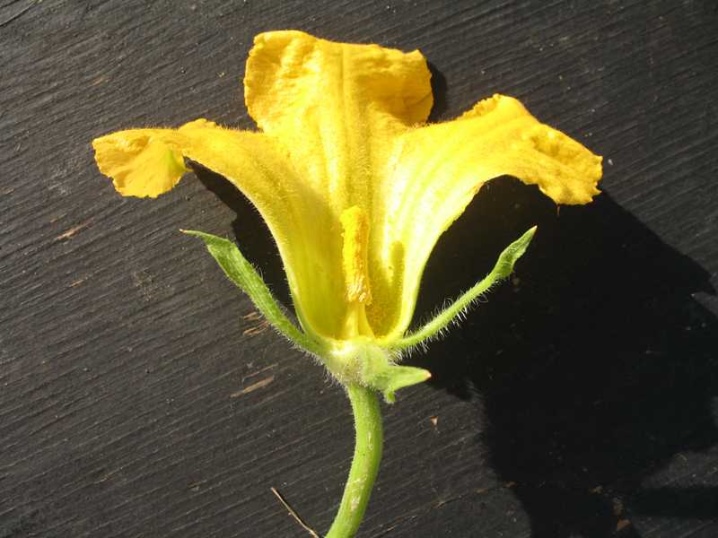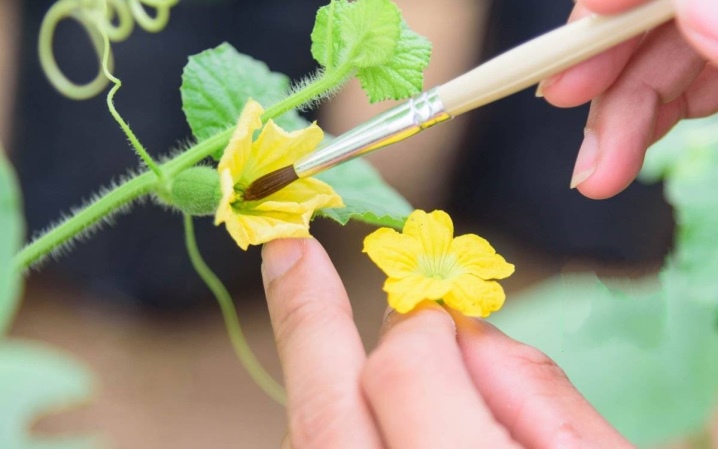All about the flowering of cucumbers

A bountiful harvest of strong crispy cucumbers is the dream of any gardener. It happens that the plant blooms profusely, but bears very little fruit, or even remains a green decor in the beds.
To avoid disappointments and false hopes, you need to know the peculiarities of the flowering of cucumbers.

Structure
Regardless of the variety, cucumber flowers have 5 bright yellow lanceolate petals. They are tapered at the outer edge and can be slightly curved outward. All petals together form a corolla. From the outside, it is supported by fused green leaves, which are called a calyx or sepal.
At the base of the corolla, on its inner side, there is a receptacle, on which such plant organs as the pistil and stamens are located. Their presence or absence is determined by the sex of the flower.
The stamens are male organs. They consist of a filament and an anther, inside which is pollen (microsporangia). A flower that has this organ is called staminate.

The pistil is the female organ of the plant. It consists of a stigma, a column and an ovary. After pollen enters the stigma (pollination process), the fruit begins to develop from the ovary. Depending on the type of cucumber, the ovary can be upper (located inside the calyx) or lower (located outside, between the stem and the flower). Such flowers are called pistillate.
Cucumbers do not form inflorescences. The flowers of these plants are solitary, although they can be located close to each other on the stem. But each of them has its own peduncle, and depending on the gender, it differs in length. Where a fruit can be expected, the peduncle will be short with a noticeable thickening. The so-called "barren flowers" grow on long stems in order to more actively attract insects.
By how the flower looks and what organs it has, determine its sex and importance in the life cycle of the plant.

Floor
Distinguish between male, female and bisexual (hermaphroditic) cucumber flowers. Each species is distinguished by its structural features and its own biological task.
The male flowers have only stamens inside the corolla. Their task is to participate in the pollination of female plants. They do not form ovaries and bloom rather quickly. Soon after pollination, the pistillate flowers dry up and fall off; in their place, only a thin pedicel remains on the stem.

Female flowers are pistillate. In most modern varieties of cucumbers, the ovary develops in them simultaneously with the beginning of flowering.
Even before pollination begins, a tiny cucumber is already visible on the stem in front of the female flower, which will later develop into a full-fledged fruit. After the female flower has fulfilled its biological function, it dries up and disappears, and the cucumber remains on the stem to ripen. It often happens that at the end of a mature fruit, the petals of a dried flower are preserved.

Hermaphrodites have a complete set of organs - both the pistil and the stamens. They have an ovary and they produce fruits. Studies have shown that it is precisely this flowering of cucumbers that is primary in the evolutionary sense. However, hermaphrodite plants have not been used in the gardening industry. They have a low yield, and the fruits are of unsatisfactory taste.
Hermaphrodite cucumbers are now used mainly for scientific purposes and in breeding work. It is not difficult to distinguish flowers by sex. It is enough just to see what organs are inside his calyx. By the prevailing flowers of which sex, you can determine how rich the harvest should be expected.Only female plants bear fruit.

The need for pollination
Depending on which flowers prevail on the plant, its gender is also determined. Most modern cucumber varieties are dioecious. This means that predominantly female flowers will appear on one plant, and it is from it that they will harvest in the future. And in order to have a lot of fruits, it is necessary to have a nearby male plant with a predominance of staminate flowers. It will not give a crop, but will participate in the pollination of female plants.
It happens that there are many female flowers on the bushes, but for some reason they do not attract insects, and pollination does not occur. This is a direct threat to not harvest. There is no hope for wind pollination. Cucumber pollen is relatively heavy and rather sticky, and the structure of the plant is such that it is practically impossible to carry it by air currents.
In this case, it is necessary to play the role of bees and bumblebees, touching with a soft brush alternately to the anthers of male flowers and the stigma of female flowers.

But if only male flowers have grown on the bushes, the harvest will be very poor or, altogether, absent. It is already very difficult to fix this at the flowering stage. It is better to take measures to stimulate plants to acquire female characteristics. Low productivity occurs in stressful situations - drought, overheating, poor adaptation in the soil. After planting in the ground, the cucumbers must be shaded and watered abundantly, provided with additional mineral dressings. In such conditions, the biological program for reproduction will work, and female flowers, and subsequently the fruits, will certainly appear in large quantities.
Modern breeders have developed self-pollinated plants, the female bushes of which do not need the proximity of male plants. Such varieties are called parthenocarpic. You can learn about this ability from the description of the variety. A feature of such fruits is the absence of seeds in them. Experienced gardeners prefer varieties of this type, most of them are early maturing and allow you to get a rich harvest.

There is a definite relationship between variety type, yield and gender. Female plants of short-fruited varieties produce about 1 male flower in 10 female ones. These bushes are very productive. In long-fruited cucumbers, much fewer pistillate flowers are formed, from which fruits will appear - no more than 2-3 per 1 staminate.
You should not rush to determine the floor of the bush and assess the need for additional pollination. Female and male inflorescences develop at different rates.
Therefore, the situation should be assessed when there are almost no buds left on the plant, and the structure of most flowers can be seen.

The flowering process must be closely monitored. If the flowers begin to dry out and wrinkle, and the ovaries at least the size of a little finger have not yet formed, this is an alarming signal. The plant gets rid of inflorescences and refuses to produce fruits, saving energy in case of serious diseases, attack of insect pests and stress. The following should be done: immediately identify and eliminate the factor that threatens the health of garden crops.














The comment was sent successfully.